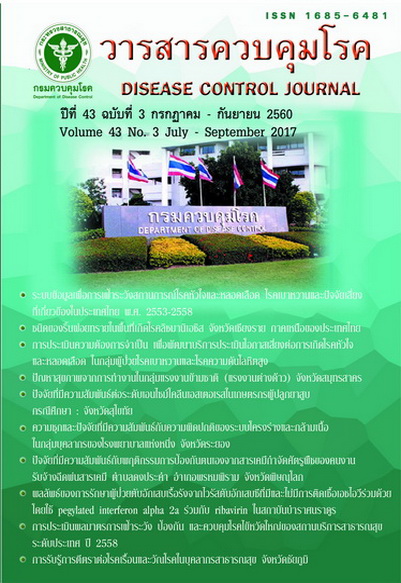Data system for surveillance of cardiovascular disease, diabetes and related risk factors in Thailand during 2010-2015
DOI:
https://doi.org/10.14456/dcj.2017.11Keywords:
surveillance, cardiovascular disease, diabetes, risk factor, ThailandAbstract
This study has collected the data from ranges of related data and interviewing health personnel working in health care service and information system at different levels to describe the existing surveillance of the diseases and risk factors in Thailand during year 2010-2015 corresponding to NCD global strategies. The reviewed database was categorized into 5 groups including death certificate, hospital or health care service, survey, program response, and non-health sectors. Death certificate is the main system to monitor mortality but the accuracy of diagnosing causes of death still need improvement especially chronic diseases such as NCDs. There are 2 major health service-based data systems available including 43-electronic file and Universal Health Coverage data, however the problem in transferring data still needs to be solved. There were several NCD related national surveys; 12-population database and one health service database. Among those surveys, only 3 surveys have been commonly used for situation monitoring namely the survey of National Statistic Office, National Health Exam Survey and Behavioral Risk Factor Surveillance System. Nonetheless, the different definitions of indicators, representability in different population levels and conducting surveys in the same year have limited fully utilizing indicators. Monitoring the processes of prevention and control measures and other related determinants, social environment and economics, from non-health sectors are also crucial to systematize the complicated NCD surveillance but they have just been considered and promoted. Integration of multiple data sources including death certificate, health service, risk factor and behaviors, social and environment and health literacy should be done with emphasizing the high coverage, quality and representativeness at both national and provincial levels. The surveillance system and networks in non-health sectors should be developed and strengthened to cover major groups of population such as school and workplace. Furthermore, capacity building in terms of human, networks, tools and systems should be focused in parallel to support more effective surveillance system.
Downloads
References
2. อรดี อินทร์คง. นักสืบความเสียชีวิต ก้าวสำคัญของ การปฏิรูประบบข้อมูลสุขภาพ. กรุงเทพมหานคร: ต้นคิด; 2553.
3. สำนักงานพัฒนาระบบข้อมูลข่าวสารสุขภาพ. ไขปริศนาการเสียชีวิต ยกเครื่องระบบข้อมูลการ เสียชีวิต. หมออนามัย 2553;19:37-41.
4. อรรถเกียรติ กาญจนพิบูลวงศ์, สุพัตรา ศรีวณิชชากร. สถานการณ์โรคไม่ติดต่อ และปัจจัยเสี่ยงต่อโรคไม่ติดต่อและการจัดระบบบริการเพื่อตอบสนอง ต่อโรคไม่ติดต่อตามเป้าหมาย และตัวชี้วัดระดับโลก ของประเทศไทย. กรุงเทพมหานคร: สหมิตรพริ้นติ้ง แอนด์พับลิสชิ่ง; 2559.
5. สำนักนโยบายและยุทธศาสตร์ สำนักงานปลัด กระทรวง สาธารณสุข. คู่มือการปฏิบัติงานการจัดเก็บ และจัด ส่งข้อมูลตามโครงสร้างมาตรฐานข้อมูลด้านการ แพทย์และสุขภาพ และข้อมูลส่งต่อผู้ป่วย 50 แฟ้ม ปีงบประมาณ พ.ศ. 2556 [อินเทอร์เน็ต]. [สืบค้น เมื่อ 20 พ.ย. 2559]. แหล่งข้อมูล: http://health¬caredata.moph.go.th/main/
6. อรรถเกียรติ กาญจนพิบูลวงศ์, วิชุตา บุษบงค์. คู่มือ บัญชีตัววัดสำคัญสำหรับการเฝ้าระวังโรคเบาหวาน โรคหัวใจและหลอดเลือด และปัจจัยเสี่ยงที่เกี่ยวข้อง ปี พ.ศ. 2553-2558. กรุงเทพมหานคร: องค์การ สงเคราะห์ทหารผ่านศึก; 2558.
7. สำนักนโยบายและยุทธศาสตร์ สำนักงานปลัด กระทรวงสาธารณสุข. แผนยุทธศาสตร์สุขภาพดีวิถี ชีวิตไทย พ.ศ. 2554-2563.กรุงเทพมหานคร: สำนักงานพระพุทธศาสนาแห่งชาติ; 2554.
8. อรรถเกียรติ กาญจนพิบูลวงศ์. การเฝ้าระวังเหตุการณ์ สำหรับโรคไม่ติดต่อเรื้อรัง. วารสารควบคุมโรค 2559;42:1-10.
9. ธนรักษ์ ผลิพัฒน์, เสาวพักตร์ ฮิ้นจ้อย, คำนวณ อึ้งชูศักดิ์. การเฝ้าระวัง 5 กลุ่มโรค 5 มิติ. กรุงเทพ มหานคร: ฮีร์; 2557.
10. Center for Disease Control and Prevention. What is health literacy? 2016 [Internet]. [cited 2017 Jan 2]; Available from: https://www.cdc.gov/ healthliteracy/learn/
Downloads
Published
How to Cite
Issue
Section
License
Articles published in the Disease Control Journal are considered as academic work, research or analysis of the personal opinion of the authors, not the opinion of the Thailand Department of Disease Control or editorial team. The authors must be responsible for their articles.






